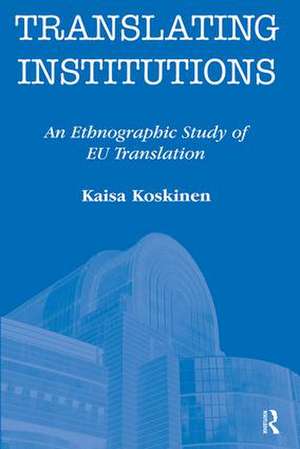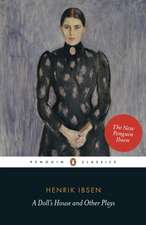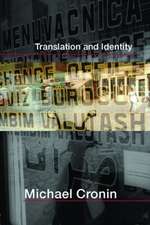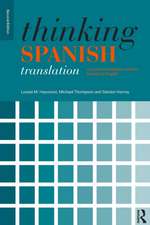Translating Institutions: An Ethnographic Study of EU Translation
Autor Kaisa Koskinenen Limba Engleză Paperback – 4 apr 2008
Translating Institutions adopts an ethnographic approach to explore the life and work of the translators at the centre of this study. In practice, this entails employing a number of different methods and interrogating various types of data. The three-level research design used covers the study of the institutional framework, the study of translators working in specific institutional settings, and the study of translated documents and their source texts. This is therefore a study of both texts and people in their institutional habitat. Given the methodological focus of the volume, the different methods and data are outlined in independent chapters: the institutional framework of translation (institutional ethnography), the physical location of the unit (observation), translators' own views of their role (focus group discussions), and a sociologically-oriented text analysis of a sample document (shifts analysis).
Translating Institutions constitutes a valuable contribution to the sociology of translation. It opens up new avenues for research and offers a detailed framework for the study of institutional translation.
| Toate formatele și edițiile | Preț | Express |
|---|---|---|
| Paperback (1) | 251.39 lei 43-57 zile | |
| Taylor & Francis – 4 apr 2008 | 251.39 lei 43-57 zile | |
| Hardback (1) | 764.20 lei 43-57 zile | |
| Taylor & Francis – 9 mai 2016 | 764.20 lei 43-57 zile |
Preț: 251.39 lei
Preț vechi: 298.42 lei
-16% Nou
Puncte Express: 377
Preț estimativ în valută:
48.10€ • 50.36$ • 39.80£
48.10€ • 50.36$ • 39.80£
Carte tipărită la comandă
Livrare economică 07-21 aprilie
Preluare comenzi: 021 569.72.76
Specificații
ISBN-13: 9781905763085
ISBN-10: 1905763085
Pagini: 188
Dimensiuni: 156 x 234 x 13 mm
Greutate: 0.65 kg
Ediția:1
Editura: Taylor & Francis
Colecția Routledge
Locul publicării:Oxford, United Kingdom
ISBN-10: 1905763085
Pagini: 188
Dimensiuni: 156 x 234 x 13 mm
Greutate: 0.65 kg
Ediția:1
Editura: Taylor & Francis
Colecția Routledge
Locul publicării:Oxford, United Kingdom
Public țintă
PostgraduateCuprins
1. Introduction
Net-weaving
The European Commission as a translated institution
Ethnography: a weaving method
Small is beautiful
Role of the researcher
The logic of both/and
Aims and structure of the book
PART I
2. Translating institutions and institutional translation
2.1. Institutions
2.2. Rules, norms, and beliefs
2.3. Institutional translation
2.4. Categories of translated institutions
Supra-national institutions
Multilingual and bilingual administration
Public services
2.5. Translating institutions and translator training in Finland
3. Ethnographic approach to institutional translation
3.1. How to research institutional translation?
3.2. Essentials of ethnography
3.3. Ethnography in translating institutions
3.4. Probing cultural relations
Operationalizing culture
Nexus approach to culture
3.5. Identifications
Split identities
Questioning identification
Textual identities
3.6. Who is who: Positioning myself
Reminiscences
Ethical considerations
PART II
4. Language work in the European Commission
4.1. Institutional Ethnography
4.2. Framework documents
Institutional multilingualism
Building Europe
Legal selves in a law-based administration: Staff Regulation
4.3. Translating in the European Commission
DGT
Mission
Material environment: JMO
The Finnish Unit
4.4. Living in Luxembourg
4.5. Conclusions
5. Institutional identifications
5.1. European identities
5.2. Provoking representations with the help of focus groups
Ethnography and focus groups
Focus groups in the translation unit
Mind map and questionnaire
Transcription and translation
Limits of focus groups
5.3. Translation unit as a nexus of relations
Officials and translators
Socialization to the organization
Socialization to the profession: the issue of educational background
Readers and readability
Transnational expatriates
5.4. The role of laughter
Laughing together
Laughing at ambiguities
5.5. Conclusion
6. Institutional text production
6.1. Social study of texts
Mapping the process
Focus on shifts
Focus on interpersonal shifts
6.2. Drafting process
Political redrafting (ORI-00 → ORI-01)
Institutional redrafting (ORI-01 → ORI-02)
Reframing the document (ORI-02 → ORI-03)
Drafting process: summary
6.3. Translation process
Communicating in Finnish (independent reading of TRA-02)
Continued institutionalization (ORI-02 → TRA-02)
Analysis of shifts vs. independent reading
Improved AND deteriorated version (ORI-03 →TRA-03)
Translation process: summary
6.4. From shouldness to maybeness?
6.5. Conclusions: Us and them
7. Net results
7.1. Rules, norms and beliefs: the question of culture in institutional translation
7.2. Readability
7.3. Recognition
7.4. Towards reflexive practice
Net-weaving
The European Commission as a translated institution
Ethnography: a weaving method
Small is beautiful
Role of the researcher
The logic of both/and
Aims and structure of the book
PART I
2. Translating institutions and institutional translation
2.1. Institutions
2.2. Rules, norms, and beliefs
2.3. Institutional translation
2.4. Categories of translated institutions
Supra-national institutions
Multilingual and bilingual administration
Public services
2.5. Translating institutions and translator training in Finland
3. Ethnographic approach to institutional translation
3.1. How to research institutional translation?
3.2. Essentials of ethnography
3.3. Ethnography in translating institutions
3.4. Probing cultural relations
Operationalizing culture
Nexus approach to culture
3.5. Identifications
Split identities
Questioning identification
Textual identities
3.6. Who is who: Positioning myself
Reminiscences
Ethical considerations
PART II
4. Language work in the European Commission
4.1. Institutional Ethnography
4.2. Framework documents
Institutional multilingualism
Building Europe
Legal selves in a law-based administration: Staff Regulation
4.3. Translating in the European Commission
DGT
Mission
Material environment: JMO
The Finnish Unit
4.4. Living in Luxembourg
4.5. Conclusions
5. Institutional identifications
5.1. European identities
5.2. Provoking representations with the help of focus groups
Ethnography and focus groups
Focus groups in the translation unit
Mind map and questionnaire
Transcription and translation
Limits of focus groups
5.3. Translation unit as a nexus of relations
Officials and translators
Socialization to the organization
Socialization to the profession: the issue of educational background
Readers and readability
Transnational expatriates
5.4. The role of laughter
Laughing together
Laughing at ambiguities
5.5. Conclusion
6. Institutional text production
6.1. Social study of texts
Mapping the process
Focus on shifts
Focus on interpersonal shifts
6.2. Drafting process
Political redrafting (ORI-00 → ORI-01)
Institutional redrafting (ORI-01 → ORI-02)
Reframing the document (ORI-02 → ORI-03)
Drafting process: summary
6.3. Translation process
Communicating in Finnish (independent reading of TRA-02)
Continued institutionalization (ORI-02 → TRA-02)
Analysis of shifts vs. independent reading
Improved AND deteriorated version (ORI-03 →TRA-03)
Translation process: summary
6.4. From shouldness to maybeness?
6.5. Conclusions: Us and them
7. Net results
7.1. Rules, norms and beliefs: the question of culture in institutional translation
7.2. Readability
7.3. Recognition
7.4. Towards reflexive practice
Notă biografică
Kaisa Koskinen is Lecturer and Adjunct Professor at the School of Modern Languages and Translation Studies, University of Tampere, Finland. She is author of Beyond Ambivalence: Postmodernity and the Ethics of Translation (2000) and various articles that examine theoretical and methodological questions in translation studies, retranslation, translation in the European Union, and the ethics of translation. Her interest in EU translation stems from her previous insider role as a translator working for the European Commission.
Descriere
Translating Institutions outlines a framework for research on translation in institutional settings, using the Finnish translation unit at the European Commission as a case study








